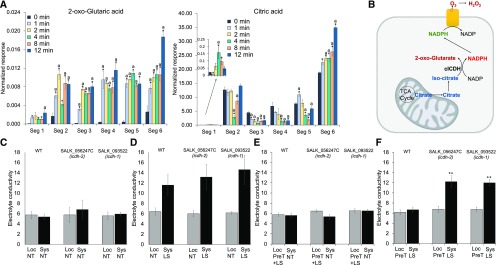Figure 5.
Possible involvement of cICDH in supporting the initiation/propagation of systemic signals during SAA to light stress. A, Bar graphs showing changes in the levels of 2-oxoglutaric acid and citric acid in response to light stress applied to a local rosette leaf. See Figure 1A for the experimental design. Results are presented as means ± se of three biological replicates each with 40 plants per time point. Significant changes (P < 0.05) from time zero (0 min) in each segment (Seg) were calculated using an ANOVA followed by Dunnett’s test (indicated with letter a) or a two-tailed Student’s t test (indicated with an asterisk). B, Hypothetical model showing the conversion of citrate to isocitrate first via aconitase and then to 2-oxoglutaric acid via cICDH, directly yielding NADPH that could be used during systemic signaling (e.g. RBOHD function). TCA, Tricarboxylic acid. C to F, Local (Loc) and systemic (Sys) acclimation of wild-type (WT) plants and mutants deficient in cICDH function (SALK_056247C and SALK_093522) to light stress. C, Conductivity measurements of local and systemic leaves in the absence of any light stress or pretreatment of leaves with light stress (NT, nontreated). D, Conductivity measurements of local and systemic leaves following the application of light stress (LS) to systemic leaves. E, Conductivity measurements of local and systemic leaves following pretreatment of local leaves (PreT) and the application of light stress to local leaves (+LS). F, Conductivity measurements of local and systemic leaves following pretreatment of local leaves and the application of HL stress to systemic leaves. Results are presented as means ± se of three biological replicates each with 30 plants per time point; **, P < 0.01 (Student’s two-tailed t test).

